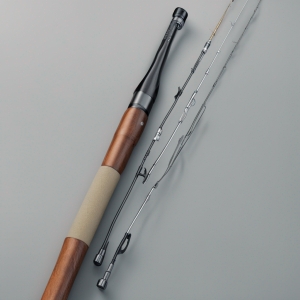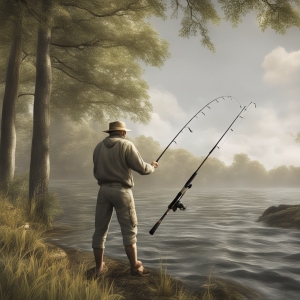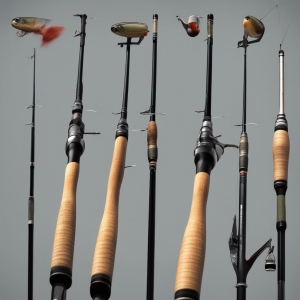Table of Contents:
Introduction: The Art of Choosing a Fishing Rod
Fishing is more than just a sport or a pastime – it's an art. It is the art of patience, skill, and, above all, understanding your equipment. One essential piece of gear that every angler needs to get right is the fishing rod. Your fishing prowess largely depends on this vital tool. You might wonder, with the abundance of options in the market, how do you select the 'right' fishing rod? Whether you're a beginner just getting your feet wet or a seasoned angler looking to step up your game, this guide will help you navigate your way to the perfect fishing rod to suit your needs.
Understanding the Basics: Types of Fishing Rods
The first step towards choosing the right fishing rod is understanding the different types available. There are several, each designed for specific situations, techniques, and species of fish. Some of the primary types include:
Spinning rods: Appreciated for their ease of use, spinning rods are ideal for beginners. They're designed to hold a spinning reel, which sits beneath the rod in use, making it naturally comfortable for most anglers.
Casting rods: Designed for maximum accuracy during casts, these rods accommodate baitcasting or spincast reels. They're a popular choice among advanced anglers.
Fly fishing rods: These special rods are used for fly fishing - a technique involving lightweight lures. Fly rods are designed to cast line instead of lure, making them distinctly different from other types.
Telescopic rods: Known for their portability, telescopic rods collapse down into a compact size, making them perfect for camping trips or hiking adventures where space is a concern.
Understanding these basics will help you narrow down your options, but it's crucial to remember that the best rod for you depends on your specific needs and preferences.
Pros and Cons: Choosing the right fishing rod
| Aspects | Pros | Cons |
|---|---|---|
| Price | Beginner rods are affordable | High-quality rods can be expensive |
| Usability | Excellent for newcomers to learn basics | May not provide enough versatility for advanced anglers |
| Durability | Advanced models are typically more durable | Beginner rods can be prone to damage |
| Performance | Greater performance with high-quality rods | Beginner rods may lack in performance when fishing for larger game |
Material Matters: What Your Rod is Made Of

The construction material of a rod significantly affects its performance and durability. The most common materials used today include:
Graphite: Graphite rods are popular due to their sensitivity, enabling you to feel even the slightest nibble on the line. They're typically lightweight and come with a fast action, making them ideal for targeting species that require finesse.
Fiberglass: These rods are renowned for their ruggedness. Fiberglass fishing rods offer a slower action and are generally heavier than graphite rods. However, they are nearly indestructible and require little maintenance, making them a good choice for beginners or for fishing in rough conditions.
Composite: Composite rods are a blend of graphite and fiberglass, offering a balance between sensitivity and strength. They are versatile and are well-suited to anglers who fish for a variety of species.
Remember, there's no 'best' material as each comes with its benefits. Your individual needs and style of fishing will dictate what's right for you.
The Right Length: How Long Your Rod Should Be
The length of your fishing rod dramatically impacts its performance. Rods can range anywhere from 4 feet to 14 feet long. So how do you know the right length for you?
Short rods: If you're a new angler or you intend to fish in small streams or windswept areas, then short rods (4 to 6 feet) are your ideal companions. Short rods offer great control and accuracy, making them excellent for shorter casts and catching small to medium-sized fish.
Medium length rods: Anything around 7 feet is considered medium length. These all-around rods are versatile, allowing longer casts than shorter rods while still maintaining a good level of control.
Long rods: Long rods (over 8 feet) might be challenging to handle for beginners, but they allow extra long casts, making them perfect for surf fishing or when the fishing spot is far from the shore.
Understanding your fishing environment and targeted species would largely dictate the length of the rod you need.
Conquering the Complexity: Understanding Rod Actions and Power

Let's delve a bit deeper and tackle two more critical features of fishing rods - action and power. These terms may sound complex, but understanding them is essential for choosing the right rod for you.
Action: Describes how and where a rod bends when pressure is applied. There are three primary types:
Fast action: These rods bend mostly in the top third. They allow for better sensitivity and faster power application, ideal for handling large fish or for using heavy lures.
Medium action: Medium action rods bend in the top half. They provide a balance of power, sensitivity, and casting distance, suited to a wide array of fishing situations.
Slow action: Slow or light action rods bend starting from the lower third. They are perfect for short casting distances and provide more casting accuracy, which is useful for light bait and small fish.
Power: Also known as "rod weight," it refers to the amount of force required to flex the rod. The power can range from ultra-light to extra-heavy, each catering to the size and type of fish you intend to catch:
Light power rods: Ideal for lightweight lures and for catching small species like trout and panfish.
Medium power rods: They're suitable for a variety of fish species and fishing conditions. Medium power rods are excellent for intermediate anglers.
Heavy power rods: Intended for big game fishing, heavy power rods work best for large species like catfish, salmon, or northern pike.
In essence, the action and power of your fishing rod should align with the type of fishing you plan to do. Consider the species you aim to catch, the size of your bait, and your fishing conditions.
Putting it All Together: Tips for Choosing Your Perfect Rod
Now that you're acquainted with the basics of a fishing rod, it's time to compile this knowledge and make an informed decision. Here are a few fundamental tips to help you in your quest for the perfect rod:
Consistency is key: Select a rod that matches your style of fishing and the type of fish you aim to catch. Consistency from your rod to your reel up to your fishing line creates a balance that enhances your overall performance.
Don't neglect comfort: Always opt for a rod that feels good in your hands. It should be lightweight enough to handle for long periods and well-balanced to help you cast accurately.
Consider the environment: If you intend to go saltwater fishing, ensure that the rod you choose can withstand the harsh conditions. Also, your rod should be capable of handling the type of water you'll be fishing in, whether it's a calm lake or a fast-flowing river.
Invest in quality: Price should not be the sole deciding factor. A cheap rod might save you money initially but can break easily or perform poorly, which could cost you in missed opportunities and continued replacement costs. It's worth it to invest in a good-quality rod that can last for years.
By following these tips, you can confidently choose the right fishing rod that will step up your fishing game and provide an enjoyable experience.
Conclusion: Your Perfect Fishing Rod Awaits

Choosing the right fishing rod can seem daunting with the vast array of options. Yet, understanding the basic aspects such as type, material, length, action, and power can guide you towards the right direction. Remember, the perfect rod is not about finding the most expensive or the one with the most features. It's about finding a rod that best suits your specific needs, style of fishing, and level of comfort. Armed with this guide and a bit of patience, you are well on your way to finding a fishing rod that won't just enhance your fishing exploits but will make every catch feel like a victory.
Conclusion: Ace your Fishing Experience with the Ideal Rod
In essence, finding the perfect fishing companion in the form of a rod isn't a one-size-fits-all process. It's an adventure in itself, guided by personal preferences and the fishing conditions you expect to encounter. Never forget - it is not only the rod that fishes, but the angler who wields it. Thus, prioritising comfort and balance in handling will also vastly affect your overall fishing experience.
So venture out, experiment, and don’t be afraid to get your feet wet, or rather, get your hands on different rods. It’s part of the journey to being an experienced angler. And when you find 'the one,' your favourite fishing rod, you’ll know it – fishing will feel less challenging and far more rewarding. But until then, let this guide be your starting point in selecting the right fishing rod. Happy fishing!
Frequently Asked Questions on Fishing Rod Selection
What are the main types of fishing rods?
There are five main types of fishing rods: Spinning, Fly, Casting, Ice Fishing, and Trolling rods. Each type is specifically designed for different fishing techniques and types of water.
How do I choose the right fishing rod length?
The right length of your fishing rod depends on the location and type of fishing. Short rods are ideal for close combat and heavy cover, while long rods work well for surfcasting or fly fishing where reach and line control are necessary.
What is rod action and how does it affect my fishing?
Rod action is the speed at which the rod returns to its neutral position. Faster actions are ideal for long casts with light lures, while slower actions are better for short casts with heavy lures.
How do I pick the right fishing rod for my skill level?
Beginners should start with a medium-action spinning rod for its flexibility and wide range of use. More skilled anglers might select a rod more tailored for the specific fishing method to increase casting accuracy and control.
What factors should I consider when choosing a fishing rod?
There are many factors to consider such as the rod material, weight, length, action, power, line guides and handle. However, the choice will also depend on your fishing style, target species and personal preferences.







